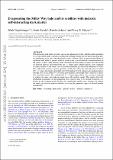| dc.contributor.author | Vogelsberger, Mark | |
| dc.contributor.author | Zavala, Jesús | |
| dc.contributor.author | Schutz, Katelin | |
| dc.contributor.author | Slatyer, Tracy Robyn | |
| dc.date.accessioned | 2020-10-06T22:42:05Z | |
| dc.date.available | 2020-10-06T22:42:05Z | |
| dc.date.issued | 2019-02 | |
| dc.date.submitted | 2018-11 | |
| dc.identifier.issn | 0035-8711 | |
| dc.identifier.issn | 1365-2966 | |
| dc.identifier.uri | https://hdl.handle.net/1721.1/127821 | |
| dc.description.abstract | Self-interacting dark matter provides a promising alternative for the cold dark matter paradigm to solve potential small-scale galaxy formation problems. Nearly all self-interacting dark matter simulations so far have considered only elastic collisions. Here we present simulations of a galactic halo within a generic inelastic model using a novel numerical implementation in the arepo code to study arbitrary multistate inelastic dark matter scenarios. For this model we find that inelastic self-interactions can: (i) create larger subhalo density cores compared to elastic models for the same cross-section normalization; (ii) lower the abundance of satellites without the need for a power spectrum cut-off; (iii) reduce the total halo mass by about 10 per cent; (iv) inject the energy equivalent of O(100) million Type II supernovae in galactic haloes through level de-excitation; (v) avoid the gravothermal catastrophe due to removal of particles from halo centres. We conclude that a ∼5 times larger elastic cross-section is required to achieve the same central density reduction as the inelastic model. This implies that well-established constraints on self-interacting cross-sections have to be revised if inelastic collisions are the dominant mode. In this case significantly smaller cross-sections can achieve the same core density reduction thereby increasing the parameter space of allowed models considerably.
normalisation; (ii) lower the abundance of satellites without the need for a
power spectrum cutoff; (iii) reduce the total halo mass by about 10%; (iv)
inject the energy equivalent of O(100) million Type II supernovae in galactic
haloes through level de-excitation; (v) avoid the gravothermal catastrophe due
to removal of particles from halo centers. We conclude that a ~5 times larger
elastic cross section is required to achieve the same central density reduction
as the inelastic model. This implies that well-established constraints on
self-interacting cross sections have to be revised if inelastic collisions are
the dominant mode. In this case significantly smaller cross sections can
achieve the same core density reduction thereby increasing the parameter space
of allowed models considerably. | en_US |
| dc.description.sponsorship | NASA (Grant NNX17AG29G) | en_US |
| dc.description.sponsorship | NSF (Grants AST-1814053 and AST-1814259) | en_US |
| dc.description.sponsorship | U.S. Department of Energy, Office of High Energy Physics (Grants DE-SC00012567 and DE-SC0013999) | en_US |
| dc.language.iso | en | |
| dc.publisher | Oxford University Press (OUP) | en_US |
| dc.relation.isversionof | http://dx.doi.org/10.1093/mnras/stz340 | en_US |
| dc.rights | Creative Commons Attribution-Noncommercial-Share Alike | en_US |
| dc.rights.uri | http://creativecommons.org/licenses/by-nc-sa/4.0/ | en_US |
| dc.source | arXiv | en_US |
| dc.title | Evaporating the Milky Way halo and its satellites with inelastic self-interacting dark matter | en_US |
| dc.type | Article | en_US |
| dc.identifier.citation | Vogelsberger, Mark et al. "Evaporating the Milky Way halo and its satellites with inelastic self-interacting dark matter." Monthly Notices of the Royal Astronomical Society (February 2019): 5437–5452 © 2018 The Authors | en_US |
| dc.contributor.department | Massachusetts Institute of Technology. Department of Physics | en_US |
| dc.contributor.department | Massachusetts Institute of Technology. Center for Theoretical Physics | en_US |
| dc.contributor.department | MIT Kavli Institute for Astrophysics and Space Research | en_US |
| dc.relation.journal | Monthly Notices of the Royal Astronomical Society | en_US |
| dc.eprint.version | Author's final manuscript | en_US |
| dc.type.uri | http://purl.org/eprint/type/JournalArticle | en_US |
| eprint.status | http://purl.org/eprint/status/PeerReviewed | en_US |
| dc.date.updated | 2019-06-05T12:51:14Z | |
| dspace.date.submission | 2019-06-05T12:51:15Z | |
| mit.journal.volume | 484 | en_US |
| mit.journal.issue | 4 | en_US |
| mit.metadata.status | Complete | |
